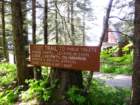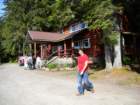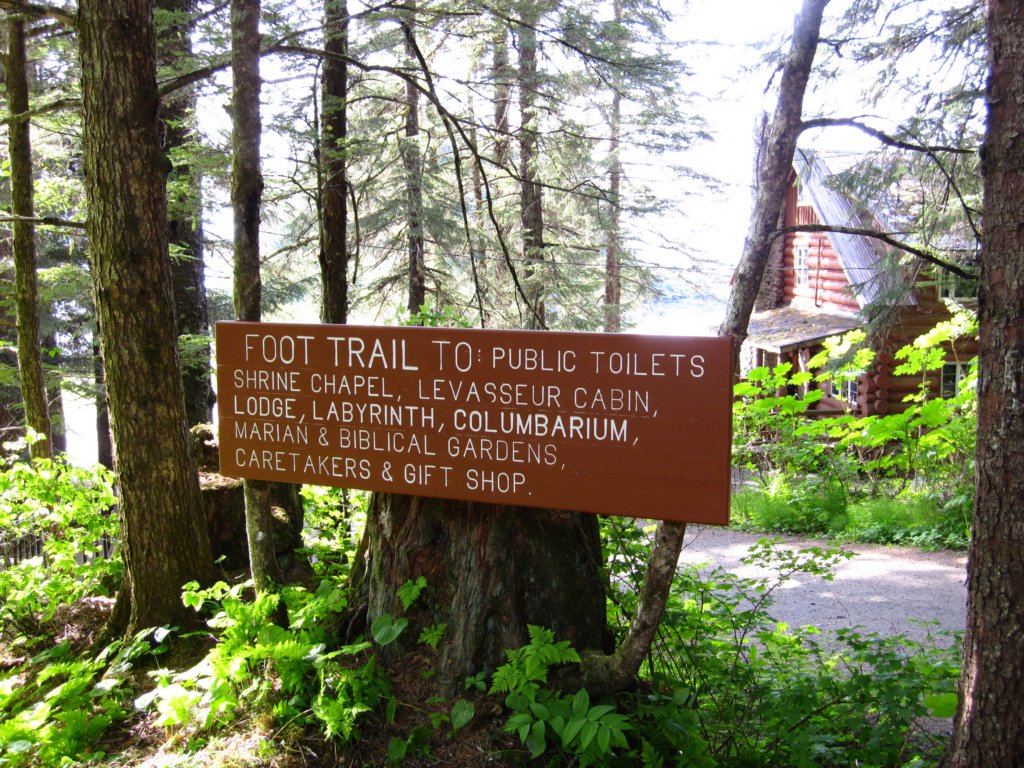| << Previous | Index | Next >> | ||
 |
 |
 |
 |
 |

History
The Shrine of St. Therese is known to local residents as a place of special beauty. Overlooking Lynn Canal, many go there to let creation and the majesty of God wash over them like a healing balm.
St. Therese of Lisieux, known as “the Little Flower of Jesus”, died September 30, 1897 in the cloistered Carmelite convent at Lisieux. Many favors and blessings, even miracles over the years, have been attributed to her intercession.
Bishop Crimont, S.J, D.D., was from St. Therese's native France and he knew members of her family. He also knew of her devotion to the missions while she was living and he placed the entire Alaskan mission under her protection five years prior to her canonization.
When St. Therese of the Child Jesus was canonized on May 17, 1925, Bishop Crimont was in Rome. At that time, she was declared Queen and Patroness of Alaska. Bishop Crimont's devotion to St. Therese grew and he did much to encourage others to develop the same devotion. It is no surprise, Bishop Crimont approved the process of making the site, located about 23 miles from downtown Juneau, Alaska a Shrine to St. Therese of Lisieux.
The Shrine of St. Therese, with a retreat house and chapel, began as a dream of Father William G. LeVasseur, S.J. He envisioned a place that would call people to a greater devotion to God. He saw the need to provide a retreat house to help bring God's people closer to the true source of all life. At this time, there wasn't another retreat house in Alaska. With the approval of Bishop Crimont and five acres secured in the forest reserve from the government, work began.
The first part of the plan was to erect the retreat house and in November 1933, that was partially completed. The donation of 35,000 feet of lumber from a Juneau firm provided material for several small cabins that could be used for private retreats and extra accommodations.
The second stage of the plan was to begin the construction of the log church on Crow Island, the tiny island located about 400 feet from the mainland shore. (It was later named Shrine Island.)
The original cost estimate for the retreat house and chapel was $3,000, not including furnishings. Considering these were depression years, fundraising was a monumental job. There was a persistent barrage of letters sent appealing for money. A.B. Cain of Juneau, editor of the Alaska Catholic, sent out as many as 500 letters each week. The parishoners of Cathedral Parish did much of the work stuffing envelopes, as well as appealing to their own friends and relatives for donations. Money was donated in varying amounts. Twenty-five cents and dollar donations were most common. Father LeVasseur wrote personal replies to each of the donors and remembered their intentions in his prayers. Many of the mailings, asking for donations and help with the project, came out of the post office established on Shrine premises. This unique feature, in operation for only eight years, served a need for the residents of the area from July, 1938 to July, 1946. Many of the requests for financial help bore the cancellation stamp of St. Therese, Alaska. Much of the incoming mail with donations came through this little post office.
Father B. H. Hubbard, known as the “Glacier Priest”, also provided support to the project. A Jesuit from Santa Clara University, Father Hubbard explored and photographed much of Alaska. In correspondence dated October 3, 1940, Father LeVasseur tells of how Father Hubbard visited for ten days and gave a lecture that raised $200 for the Shrine. The letter tells of Father Hubbard's promise to help and refers to a generator he was sending.
Many specific dates and the time schedule of completion have been lost. Through correspondence found in the Diocesan historical files, however, a picture can be painted of how building progressed.
In a fundraising notice it was stated, “The first logs for the retreat house, a necessary unit, were cut and towed to the site in 1932. The ground was broken that same year and construction was started. Owing to the lack of skilled workmen and funds, though, the work on the Shrine itself, on Shrine Island, 400 feet from the mainland, was not fully underway until the summer of 1935. The causeway joining the island with the mainland had to be built first and it proved to be quite an engineering feat owing to the high tides and severe storms.”
From correspondence of August 23, 1935, it was learned the retreat house was nearly completed. The dimensions and a description of the building were given.
It was also in 1935 that Father LeVasseur applied for and obtained an additional five acres adjacent to the original tract.
A report from Father LeVasseur as chancellor was sent to Bishop Crimont, who was at that time in Rome. The report, dated September 30, 1937, explains: “...the causeway at the Shrine has proven to be a big work, but will be finished today. The two chimneys were completed and paid for last week.
By 1937, the Shrine was also recognized as a permanent memorial to Bishop Crimont who had devoted so many years of his life to the Church and to the people of Alaska.
According to a letter sent to His Holiness, Pope Pius XII, in September of 1939, work on the chapel was not started until the summer of 1937. The letter told of a volunteer from New York City, George Murphy, who cleared off all the trees and stumps, dug the foundation and helped pour the concrete in preparation for the stone structure which was to be built the following year.
All this labor was done entirely free of charge—and without any previous experience in this line of work. Murphy returned in 1938 and assisted in building the chapel.
D.P. (Doc) Holden was foreman of the chapel construction project. A skilled stone mason, he was also responsible for the fireplace in the lodge and he supervised the enclosures of the ground space of the lodge so the pilings were no longer visible. Most likely, Holden was instrumental in the change of plans that had the chapel built of stone rather than of logs. He and his wife lived in one of the cabins on the grounds while he supervised the stone work. The rock used for the chapel was taken from the beach near the shrine.
Doc is quoted as saying: “We had a hundred dollar truck, wheelbarrow, a mortar box, mortar hoe, rope and falls for hoisting stone, and a handmade skip. There were some bad times, but the work continued, and in time the chapel structure was completed.”
Juneauite Tony Thomas recalled the laying of the cornerstone which took place on the Feast of Christ the King, October 30, 1938. The walls of the church were already up when the cornerstone was laid in the bell tower. Bishop Crimont blessed the stone which held a copper box containing time capsule items, information and a film of the blessing ceremony. Fifty years later, on October 30, 1989, the time capsule was removed and the film was found. A video of the Shrine has been produced, with some of the segments from the original film, along with other scenes of the Shrine over the years. This video is available at the Shrine Gift Shop. A new time capsule, blessed by Bishop Michael Kenney and Archbishop Francis Hurley, along with the old one, was installed on May 29, 1989. It will be opened in the year 2038.
Regarding completion of the chapel, Tony Thomas said the roof was put on and the workers began to form a crypt within the church. The chapel was built on rock so the crypt had to be blasted out. The chief blaster from the A.J. Mine, Art Reineau, did the work. Thomas said Reindeau was so skilled in blasting, there is perhaps one chip on the trusses from a flying stray stone. The crypt holds six burial places; however, Bishop Crimont and Bishop Kenney are the only persons buried there at this time.
In a letter from Father LeVasseur to George Murphy dated September 14, 1939, we find Mr. Holden returned that summer to finish the rock work on the Shrine. The crypt had been dug and cemented in. The roof had been placed and the causeway had been raised to keep the water from washing over and destroying the driveway.
Another craftsman, Henry Ellingen, who was a carpenter by trade, made the doors and woodwork in the chapel and lodge. He laid out the chapel trusses in the gym of St. Ann's School in Juneau to make sure they were accurate. They were then dismantled and put on a flat bed truck to be transported to the Shrine. Ellingen is credited with making the Alaska yellow cedar pews in the chapel. Finished, the chapel measured 63 x 28 feet, with a 10 x 10 foot Notre Dame tower 28 feet high.
The Alaska Daily Press of October 28, 1941 tells of the first Mass said in the Shrine chapel. Father LeVasseur said the Mass and Bishop Crimont blessed the bronze statue that was donated by the Nick Bez family in memory of their daughter.
Before the original project could be called finished, there remained one additional matter to ensure the perpetuity of the Shrine dream. The original land procurement was done with special use permits through the Department of Agriculture because the land was in the Tongass National Forest. The original permit was issued for the development of a residence, which came under the title of Special Use Permit. Because the development exceeded this, the purpose needed to be re-designated and the rental charge readjusted. The new permit was for an “organization site” and the annual rent was $25. This action by Regional Forester B. Frank Heintzelman seemed to precipitate the process of acquiring the original tracts along with an additional acreage so that the total land available to the Shrine would be 46.41 acres. The difficulty was the precedent 25 acres were allowed to an “industry”. A special act of Congress was required for the acquisition of the remainder of the desired property.
Support was generated with the endorsement of then Governor Gruening and the Alaska Territorial Legislature. Delegate E.L. “Bob” Bartlett introduced H.R. Bill 1992 in the U.S. Congress which authorized the sale of certain public lands in Alaska to the Catholic Bishop of Alaska, in trust for the Roman Catholic Church. The bill was approved September 24, 1945, and it became a public law of the 79th Congress. It was July 16th of the following summer that the District Land Office of Anchorage received $116.25 from the Most Reverend Walter J. Fitzgerald, S.J., Bishop of Alaska. This was the full purchase price of the tract of land.
Bishop Crimont did not live to see the security of the Shrine vision reached. He died May 20, 1945, and was buried in the crypt of the Shrine chapel. Father LeVasseur was transferred in August of that year. He had left with the hope that the security and perpetuity of the Shrine was nearly complete.
An attempt to make the Shrine more self-sufficient was initiated by Bishop O'Flanagan. In 1953, he founded “The League of the Little Flower”. His purpose to “...seek the help of St. Therese, the Little Flower, patroness of the Diocese, in providing for the spiritual and temporal needs of the Diocese”. The League continued to be in existence until 1966. In 1987, Bishop Michael Kenney reinstituted the League under the patronage of St. Therese. The principal purpose in reinstituting the League was to provide spiritual support, especially for those who are making and giving retreats.
Surrounding the chapel and built in the same type as the chapel walls—mortar and beach stone—are the fourteen Stations of the Cross. Each sheltered face is 24” x 18” and the original scene placed in it was a picture protected by a glass covering.
The damp climate penetrated these, and the 1966 cast stone figures were set in place. It was at this time that a corpus was placed on the 16 foot cross that had been erected on the rise to the west of the chapel. Again, the salt water, air, and the climate began to take its toll of the cast material. In 1986 a donation from two benefactors, Mary Toner and Verna Carrigan, enabled the Shrine governing committee to contract with a local artist to repair the existing stations.
R.D. Robinson declined to repair the stations, but did agree to create new sculptures for each of the 14 stations and create a 15th station honoring the Resurrection of Christ. Cast of alabaster with a hint of onyx, the faces of the stations are done in what Robinson describes as a contemporary Renaissance style. Robinson's work, including an additional 15th station was dedicated on May 29, 1989.
Until 1958, the Shrine chapel and lodge were used for retreats and the buildings continued to be in good condition. By 1962, the priests' retreats were no longer held at the Shrine. The buildings deteriorated and the Diocese did not have the money to maintain the facility.
A major renovation took place in 1968 and 1969 under the leadership of Father James Manske, Director of the Shrine. As in the past, there was a great deal of volunteer help that made the facility ready for a priests' retreat in May. The addition of central heating in the early 1970's extended the use of the Shrine. The summers of 1972 and 1973 saw the Shrine staffed and planned programs offered to the community. Once again, the financial drain of the Shrine maintenance forced its closure in the spring of 1985.
A small group of people, uneasy about abandoning the vision of the Shrine, would not let the dream die. They met July 24, 1985 with the goal of once again making the Shrine a viable retreat center.
With careful thought, prayer and preparation, they created this statement of purpose:
“Located in an area of exceptional beauty and solitude, the Shrine will be a place of spiritual refuge and retreat for the Diocese of Juneau, other religious groups, and when possible, for other groups utilizing it with reverance and care.”
Finally, in March of 1986, the Shrine of St. Therese was re-opened. Since that time, it has increasingly served the needs of the priests, sisters and lay people of Southeast Alaska and the thousands of visitors who annually come to the Shrine. It is open year-round, receives continued renovations, and the Shrine shows most favorable signs of life and vitality again.
With God's grace, it will continue in the future to serve the needs of His pilgrim people as they search for spiritual growth and wholeness, and as they seek and find inner peace of being.
The Shrine was built on a foundation of love and this foundation remains today. The building of love upon this foundation depends on those who are willing to continue to give love in ways of service, time and finances. All donations will be used responsibly for the good of the Shrine so that many will be blessed when they visit the Shrine.
May the beauty and peace of the Shrine of St. Therese lift your minds and hearts to the Creator of the Universe, and may that Creator bless you, heal you, and fill you with that gift of life-giving love.
Photo album created with Web Album Generator